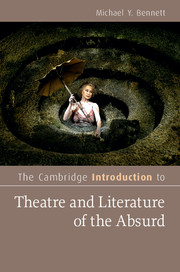Book contents
- Frontmatter
- Dedication
- Contents
- Acknowledgments
- Chapter 1 Introduction: Overview of the absurd
- Chapter 2 Setting the stage
- Chapter 3 The emergence of a “movement”: The historical and intellectual contexts
- Chapter 4 Samuel Beckett
- Chapter 5 Beckett's notable contemporaries
- Chapter 6 The European and American wave of absurdism
- Chapter 7 Post-absurdism?
- Chapter 8 Absurd criticism
- Notes
- Further reading
- Index
- Cambridge Introductions to …
Chapter 1 - Introduction: Overview of the absurd
Published online by Cambridge University Press: 05 November 2015
- Frontmatter
- Dedication
- Contents
- Acknowledgments
- Chapter 1 Introduction: Overview of the absurd
- Chapter 2 Setting the stage
- Chapter 3 The emergence of a “movement”: The historical and intellectual contexts
- Chapter 4 Samuel Beckett
- Chapter 5 Beckett's notable contemporaries
- Chapter 6 The European and American wave of absurdism
- Chapter 7 Post-absurdism?
- Chapter 8 Absurd criticism
- Notes
- Further reading
- Index
- Cambridge Introductions to …
Summary
Two men have been waiting on a country road for fifty years for a man named Godot. A woman is buried to her waist in the ground, and then buried up to her head, and continually concludes that this is a happy day. The inhabitants of a provincial French town one by one turn into rhinoceroses, until one man, who is by no means a hero, is left to face them. A transient approaches and harasses a well-to-do man sitting alone on a bench in a park and then the transient kills himself by running into a knife the man eventually holds. While still maintaining his love for his wife, an award-winning architect falls in love with a goat. A maybe former concert pianist, who is living at a seaside boarding house, is visited by two maybe unknown men and is interrogated to the point where the pianist is reduced to producing only grunts, at which point, after his supposed birthday party, the men escort the pianist away in a van. An entire novel with no perceivable plot narrated as a fractured and fragmented monologue by an unnamed, possibly immobile man. These are just some of the plots of absurd literature.
What, then, is absurdism? And what does it mean for a literary or dramatic work to be absurd? As some of the most important writers and thinkers of the twentieth century are associated with the absurd – writers such as Samuel Beckett, Albert Camus, Harold Pinter (all three being Nobel Prize winners in Literature), Edward Albee (winner of three Pulitzer Prizes and four Tony Awards), and (tangentially) Jean-Paul Sartre (who also won a Nobel Prize in Literature, but refused to accept it) – surely, many readers of this book will have some conception as to what is meant by absurdism or absurd literature. And the fact that absurd literature is thought to be a literary response to WWII brings a whole host of assumptions about what it means for something to be absurd. As The Cambridge Introduction to Theatre and Literature of the Absurd, the reader might be expecting an answer to these questions in a relatively simple and straightforward statement.
- Type
- Chapter
- Information
- Publisher: Cambridge University PressPrint publication year: 2015



